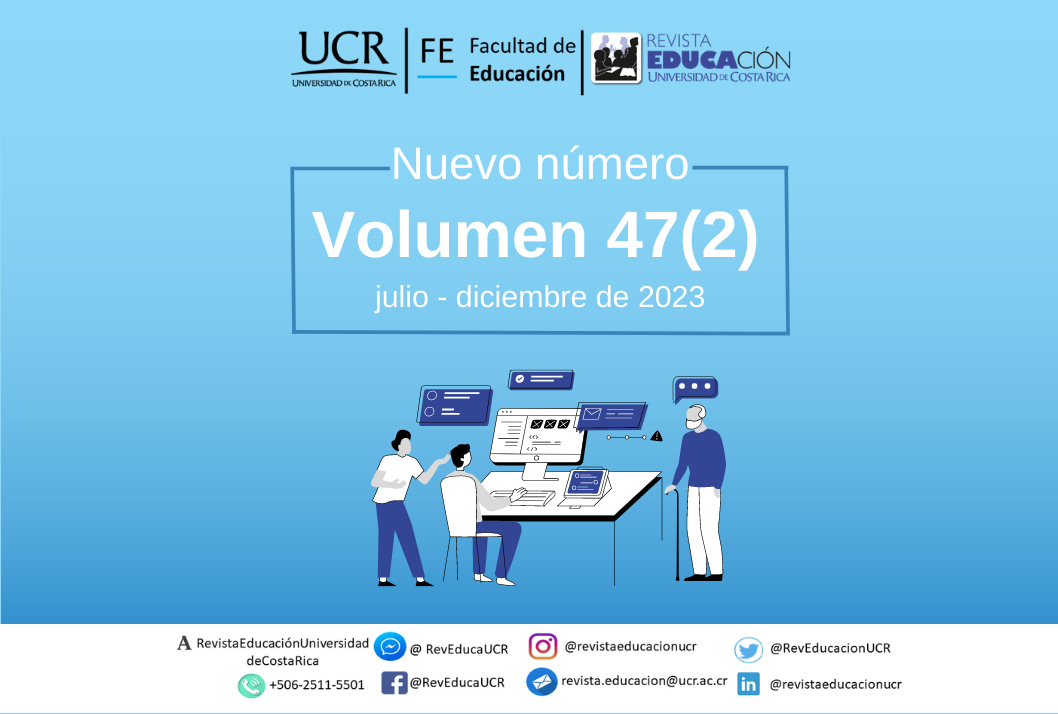Abstract
The objective of this research consisted of analyzing the perception of the physical and social self-image of two groups of ninth graders, one from a public school and the second from a private one, both from the province of San José. For this purpose, the author employed a positivist paradigm with a quantitative methodology and a descriptive scope. Since this study sought to measure physical and social self-image, the researcher designed a questionnaire for data collection and applied it to the student population during a group orientation session. Regarding the results, the author analyzed them descriptively considering frequencies and percentages. The study variables correspond to the physical and social self-image of the adolescent. Moreover, a relevant finding, in terms the main results referred to physical self-image, is that a high percentage of the students of both educational institutions stated that they were satisfied with their physical appearance. However, in relation to social self-image, a significant percentage of the population pointed out peer teasing as an unfavorable factor, generating consequences in social self-image, caused by negative comments and insults, which can be related to conflicts, problems in interpersonal relationships, and types of bullying.
References
Barrantes, R. (2005). Investigación: un camino al conocimiento, un enfoque cualitativo y cuantitativo. UNED.
Buitrago, R. y Sáenz, N. (2021). Autoimagen, Autoconcepto y Autoestima. Perspectivas Emocionales para el Contexto Escolar.
Educación y Ciencia, (24), e 12759. https://doi.org/10.19053/0120-7105.eyc.2021.25.e12759
Calvache, D. (2018). La autoimagen en la adolescencia reforzamiento del amor propio. Universidad Javeriana de Cali. https://core.ac.uk/download/pdf/161401819.pdf
Campos, D. C. y Trautner, H. M. (2004). El hombre y la mujer ideal según adolescentes en Costa Rica y Alemania. Revista Latinoamericana de Psicología, 36(3), 471-482. https://www.redalyc.org/pdf/805/80536308.pdf
Cohen, S. Esterkind, A. E., Lacunza, B. A., Caballero, V. S. y Martinenghi, C. (2011). Habilidades sociales y contexto sociocultural. Un estudio con adolescentes a través del BAS-3. Revista Iberoamericana de Diagnóstico y Evaluación, 1(29), 167-185. https://www.redalyc.org/pdf/4596/459645441010.pdf
De Mézerville, G. (2004). Ejes de salud mental. Los procesos de autoestima, dar y recibir afecto y adaptación al estrés. Trillas.
Fernández, L. G. y Azofeifa, E. G. (2007). Relación entre la satisfacción con la imagen corporal autoconcepto físico, índice de masa corporal y factores socioculturales en mujeres adolescentes costarricenses. PENSAR EN MOVIMIENTO: Revista de Ciencias del Ejercicio y la Salud, 5(1), 9-18. https://revistas.ucr.ac.cr/index.php/pem/article/view/356
Garaigordobil, M. (2000). Intervención psicológica con adolescentes. Pirámide.
García, N. I. (2004). Trastornos de la conducta alimentaria en adolescentes de ambos sexos con y sin diabetes mellitus tipo 1. [tesis doctoral, inédita]. Universidad de Barcelona. http://hdl.handle.net/10803/5436
Gimenez, P., Correché, M. S. y Rivarola, M. F. (2013). Autoestima e Imagen Corporal. Estrategias de intervención psicológica para mejorar el bienestar psicológico en pre- adolescentes en una escuela de la ciudad de San Luis, Argentina. Fundamentos en Humanidades, 14(27), 83-93 Universidad Nacional de San Luis. https://www.redalyc.org/pdf/184/18440029004.pdf
Gómez, A., Sánchez, B. J., Molina, J. y Bazaco, M. J. (2017). Violencia Escolar y Autoimagen en Adolescentes de la Región de Murcia (España). Revista Internacional de Medicina y Ciencias de la Actividad Física y del
Deporte, 17(68), 677-692. https://www.redalyc.org/pdf/542/54254647007.pdf
Hernández, R., Fernández, C. y Baptista, P. (2010). Metodología de la Investigación. Editorial McGraw-Hill.
James, H. y McMillan, S. (2005). Investigación Educativa: una introducción conceptual. Pearson Educación.
Krauskopf, D. (2014). Adolescencia y Educación. Editorial UNED.
Krauskopf, D. (2018). Adolescencia y Educación. Editorial UNED.
Llamazares, A. y Urbano, A. (2020). Autoestima y habilidades sociales en adolescentes: el papel de variables familiares y escolares. Pulso: revista de educación, (43), 99-117. https://dialnet.unirioja.es/servlet/articulo?codigo=7803963
Milicic, N. (2015). Desarrollar la autoestima de nuestros hijos: tarea familiar imprescindible. https://docplayer.es/23715480-Desarrollar-la-autoestima-de-nuestros-hijos-tarea-familiar-imprescindible.html
Monroy, J., Velázquez, G. y Galindo, E. (2020, 26-28 de setiembre). Niveles de autoestima, autoconcepto y autoimagen en adolescentes de Iztapalapa. [Ponencia]. Debates en Evaluación y Currículum. Congreso Internacional de Educación: Currículum. Universidad Nacional Autónoma de TLAXCALA, México. https://docplayer.es/226196997-Debates-en-evaluacionycurriculum- congreso-internacional-de-educacion-curriculum-2019-ano-5-no-5septiem-bre -de-2019-a-agosto-de-2020.html
Ibarra, A. y Jacobo, H. M. (2017). La evolución de la concepción de amistad a través del concepto de compañero y amigo y la trayectoria del autoconcepto social durante la adolescencia. Revista de Educación y Diversidad, 42,13-23. https://www.cucs.udg.mx/revistas/edu_desarrollo/anteriores/42/42_Ibarra.pdf
Ismail, N. A. H. y Tekke, M. (2015). Rediscovering Rogers’s self-theory and personality [Redescubriendo la teoría del yo y la personalidad de Rogers]. Journal of Educational, Health and Community Psychology, 4(3), 28-36. https://www.researchgate.net/publication/286456614_Rediscovering_Rogers%27s_Self_Theory_and_Personality
Organización Mundial de la Salud. (2003). Departamento de Salud Mental y Dependencia de Substancias. Atención de niños y adolescentes con trastornos mentales. OMS.
Papalia, D., Wendkos, S. y Duskin, R. (2004). Desarrollo Humano. Editorial McGraw-Hill Interamericana.
Reina, M. C., Oliva, A. y Parra, A. (2010). Percepciones de autoevaluación: Autoestima, autoeficacia y satisfacción vital en la adolescencia. Psychology, Society & Education, 2(1), 55-69. http://repositorio.ual.es/handle/10835/2913
Salazar, Z. (2008). Adolescencia e Imagen Corporal en la Época de la Delgadez. Reflexiones, 87(2), 67-80. https://revistas.ucr.ac.cr/index.php/reflexiones/article/view/11496
Santrock, J. (2004). Psicología del desarrollo en la adolescencia. (9a ed.). McGraw-Hill. https://toaz.info/doc-view-2
Solum, B. (2001). Adolescencia y Juventud en América Latina. LUR.
Comments

This work is licensed under a Creative Commons Attribution-NonCommercial-NoDerivatives 3.0 Unported License.
Copyright (c) 2023 Revista Educación - Journal of Education



